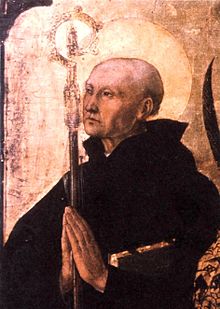Severino wa Noriko
Severino wa Noriko (410 hivi[1] – Favianae, karibu na Mautern an der Donau, 8 Januari 482) alikuwa mmisionari katika eneo hilo la Ulaya ya Kati (leo Austria, Slovenia na Bavaria) aliyepewa jina la "Mtume wa Noriko".

Tangu kale anaheshimiwa na Wakatoliki na Waorthodoksi kama mtakatifu.
Maisha
haririMwenyewe alikataa kueleza alitokea wapi kabla ya kutokea kwenye mto Danube miaka miwili baada ya kifo cha Atila kilichotokea mwaka 453. Imedhaniwa alitokea ama Italia Kusini ama Afrika Kaskazini kwa kuwa alionekana Mrumi.[3] Hata hivyo, alitaja mahusiano na wamonaki wa Mashariki, na biografia yake [4] inamhusianisha na Antoni Mkuu wa Misri. Alishika maisha magumu ya kimonaki hata mwisho, akitembea bila viatu, akivaa kanzu moja tu, akifunga chakula karibu siku zote n.k.
Mwenyewe, hasa baada ya kupewa upadrisho, pamoja na kuinjilisha kwa uthibitisho wa miujiza mingi, kulisha wenye njaa, kukomboa watumwa na kuanzisha makimbilio katika vurugu iliyosababishwa na uhamiaji mkubwa wa makabila yasiyostaarabika, alianzisha pia monasteri huko Passau, Eiferingen [5] na Favianae[6], alipofariki huku akiimba Zaburi 150.
Tazama pia
haririTanbihi
hariri- ↑ Jones, Terry. "Severinus of Noricum". Patron Saints Index. Ilihifadhiwa kwenye nyaraka kutoka chanzo mnamo 16 Machi 2007. Iliwekwa mnamo 2007-03-04.
{{cite web}}: CS1 maint: date auto-translated (link) - ↑ Martyrologium Romanum
- ↑ Kingsley, Charles (1868). The Hermits. Philadelphia: J. B. Lippincott & Co. uk. 77.
- ↑ The Vita of Severinus was written by Eugippius. Beyond Eugippius' work, the only other contemporary source that mentions Saint Severinus is the Vita beati Antonii by Magnus Felix Ennodius, bishop of Pavia.
- ↑ Paul the Deacon, in his 8th-century History of the Lombards, mentions the monastery founded by Severinus at Eiferingen, at the foot of the Kahlenberg, not far from Vienna:
In these territories of the Noricans at that time was the monastery of the blessed Severinus, who, endowed with the sanctity of every abstinence, was already renowned for his many virtues, and though he dwelt in these places up to the end of his life: now however, Neapolis keeps his remains.
- ↑ Butler, Alban. “Saint Severinus, Abbot, and Apostle of Noricum, or Austria”. Lives of the Fathers, Martyrs, and Principal Saints, 1866. CatholicSaints.Info. 7 January 2013
Marejeo
hariri- Giesriegl, K. (2013), Severin (Novel. BdP 2013)
- Attwater, Donald and Catherine Rachel John. The Penguin Dictionary of Saints. 3rd edition. New York: Penguin Books, 1993. ISBN|0-14-051312-4.
- Brown, P. (1971), The World of Late Antiquity (New York: W. W. Norton & Co).
- Eugippius und Severin: Der Author, der Text und der Heilige (Vienna: Verlag der Osterreichischen Akademie Der Wissenschaften).
- Ward-Perkins, B. (2005), The Fall of Rome and the End of Civilization (Oxford: Oxford University Press).
- Adolph Spaeth, L.D. Reed, Henry Eyster Jacobs, et Al., Trans. & Eds. Works of Martin Luther (Philadelphia: A. J. Holman Company, 1915), Vol.1, pp. 29–38.
Viungo vya nje
hariri- Eugippius, The Life of St Severinus Archived 17 Septemba 2009 at the Wayback Machine.
- Святой Северин
| Makala hii bado ni mbegu. Je, unajua kitu kuhusu Mkristo huyu, kama wasifu wake, habari za maisha au kazi yake? Je, unaona habari katika Wikipedia ya Kiingereza au lugha nyingine zinazofaa kutafsiriwa? Basi unaweza kuisaidia Wikipedia kwa kuihariri na kuiongezea habari. |